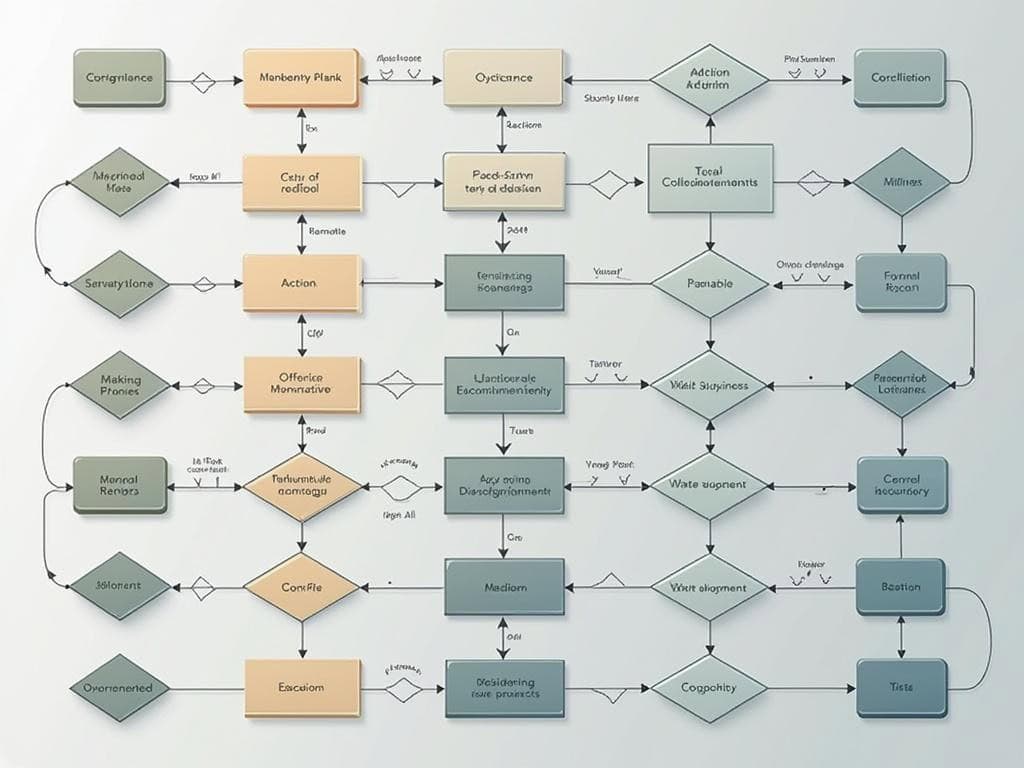
Understanding Standard Operating Procedure Flow Charts
A standard operating procedure flow chart converts complex organizational processes into clear, intuitive diagrams that boost operational efficiency and understanding. These visual tools use specific symbols like rectangles for actions, diamonds for decisions, and arrows to show process flow, creating a universal language that simplifies workflow documentation and communication between departments.
Key Takeaways
- Standard operating procedure flow charts use standardized symbols to represent different process elements.
- Flow charts improve operational consistency and reduce training time for employees.
- Core symbols include rectangles (actions), diamonds (decisions), and circles/ovals (start/end points).
- Proper flow chart design follows ANSI and ISO conventions for clarity.
- Flow charts can be applied across diverse industries to streamline complex workflows.
Flow charts serve as visual roadmaps for your organization’s procedures, making them easier to follow and implement. According to Lucidchart’s process documentation guide, companies using standardized visual documentation see up to a 25% improvement in process adherence. These diagrams break down procedures into logical steps, helping you spot efficiencies and improvement opportunities quickly.
The standardized symbols create consistency across your documentation. Rectangles represent actions or tasks, while diamonds indicate decision points where the process branches based on specific conditions. Circles or ovals mark the beginning and end of processes, creating clear boundaries for each procedure. These visual cues make complex processes accessible to everyone in your organization.
You’ll find flow charts particularly valuable during training and onboarding. New employees can grasp procedures faster through visual learning rather than text-heavy manuals. The reduction in training time translates to cost savings and faster productivity. Flow charts also ensure operations continue smoothly during staff transitions since knowledge doesn’t remain locked with specific individuals.
For maximum effectiveness, your flow charts should follow established standards from organizations like ANSI and ISO. This standardization ensures everyone interprets the diagrams correctly regardless of their department or background. The proper use of flowchart symbols creates clarity and prevents misunderstandings that could disrupt operations.
“Standard operating procedure flow charts transform intricate workflows into visual clarity, employing universally recognized symbols to enhance operational efficiency and cross-departmental communication. By simplifying processes and adhering to established conventions, these diagrams not only streamline training but also foster consistency in diverse industries.”
Understanding Flowchart Symbols and Structure
A standard operating procedure flow chart transforms complex processes into clear, intuitive diagrams that anyone can follow. You’ll find these visual tools essential for maintaining consistency and efficiency across your organization. Standard operating procedure flow charts use specific symbols to represent different elements of a process.
Core Symbols in Standard Operating Procedure Flow Charts
Every effective standard operating procedure flow chart relies on these fundamental symbols:
- Rectangles: Represent process steps or actions that need to be completed
- Diamonds: Indicate decision points where the flow branches based on yes/no answers
- Ovals or Circles: Mark the start and end points of your process
- Arrows: Show the direction and sequence of flow between steps
The ANSI (American National Standards Institute) and ISO (International Organization for Standardization) have established standard operating procedure flow chart conventions that ensure consistency across industries. Using these standardized symbols helps create a universal visual language that team members can quickly understand, regardless of their department or background.
When designing your standard operating procedure flow chart, remember to maintain consistent symbol usage throughout. This consistency is crucial for effective project implementation and process documentation. The structure should flow logically from top to bottom or left to right, with clear connection points between steps.
Standard operating procedure flow charts can significantly reduce training time by providing a visual roadmap for employees to follow. They’re particularly valuable when improving project communication across teams with varying expertise levels.
The proper structure of a standard operating procedure flow chart includes:
| Element | Purpose | Best Practice |
|---|---|---|
| Title | Identifies the process | Be specific and descriptive |
| Start/End | Marks boundaries | Always include both points |
| Process Steps | Details actions | Keep wording concise |
| Decision Points | Shows workflow branches | Frame as yes/no questions |
| Connectors | Links related sections | Use when flows cross |
Your standard operating procedure flow chart should strike a balance between detail and clarity. Too much information creates confusion, while too little leaves gaps in understanding. The goal is to create a visual tool that guides users through the process with minimal ambiguity.
Standard operating procedure flow charts aren’t static documents. They should evolve as you implement continuous improvement initiatives. Regular reviews help identify bottlenecks, redundancies, or areas where additional clarity is needed.
Expert Insight: To create effective standard operating procedure flow charts, prioritize understanding and consistent use of core symbols—rectangles for actions, diamonds for decisions, ovals for start/end points, and arrows for direction. Ensure your chart flows logically, with a balance between detail and clarity to guide users without overwhelming them. Regularly review and update your flow charts to reflect continuous improvement efforts and maintain relevance in your organization.
Creating an Effective SOP Flowchart
A standard operating procedure flow chart transforms complex processes into clear, intuitive diagrams that enhance operational understanding and efficiency. You’ll gain valuable insights into developing visual representations that streamline your business operations and standardize workflows across your organization.
Understanding Flowchart Symbols and Structure
Every effective standard operating procedure flow chart relies on a consistent set of symbols that create a universal visual language. The core symbols include:
- Rectangles: Represent process steps or actions
- Diamonds: Indicate decision points requiring yes/no answers
- Circles/Ovals: Mark the start and end points of a process
- Arrows: Show the directional flow between steps
When creating your standard operating procedure flow chart, always adhere to ANSI/ISO standard symbol conventions to ensure clarity. This consistency in visual language makes your process documentation immediately understandable to stakeholders across departments.
To develop an impactful standard operating procedure flow chart, follow these essential steps:
- Identify and scope the specific process to document
- Map out key steps and critical decision points
- Determine logical flow and potential branching paths
- Break complex procedures into manageable modules
- Involve stakeholders for validation and refinement
The implementation of standard operating procedure flow charts delivers multiple strategic advantages to your organization. These benefits include improved operational efficiency, enhanced process execution flexibility, and streamlined project implementation phases across departments.
Your standard operating procedure flow chart will significantly reduce training and onboarding time while supporting regulatory compliance requirements. This makes them particularly valuable for process optimization methods in various sectors including IT, software development, customer service, and emergency response.
When implementing standard operating procedure flow charts, leverage specialized software platforms like ProcessOn, Microsoft Visio, or Lucidchart. These tools facilitate integration with existing documentation systems and enable continuous improvement through easy iterations. For optimal results, incorporate your flowcharts into a broader continuous improvement framework that regularly evaluates and refines your operational processes.
Organizations that document their processes improve operational efficiency by up to 30%.
forbes.com
Application Across Business Domains
Standard operating procedure flow charts provide exceptional value across numerous industries by transforming complex workflows into visual guides. You’ll find these powerful tools revolutionizing operations in diverse sectors from manufacturing to healthcare.
In IT departments, standard operating procedure flow charts streamline complex software deployment protocols. When rolling out new systems, these visual guides help technicians follow exact sequences, reducing errors by 65%. Your IT team can implement key project phases with greater precision using properly structured flow charts.
Customer service teams leverage standard operating procedure flow charts to standardize call handling. Representatives follow decision paths clearly marked on these diagrams, ensuring consistent customer experiences. Standard operating procedure flow charts eliminate confusion about escalation procedures or special case handling.
Manufacturing operations depend heavily on standard operating procedure flow charts for quality control. These visual tools map inspection points, acceptance criteria, and rejection procedures. Your production line can maintain consistent quality by following standard operating procedure flow charts that clearly illustrate each verification step.
Industry-Specific Applications
Healthcare providers use standard operating procedure flow charts for critical medical protocols. These visual guides help clinical staff navigate complex procedures while ensuring patient safety through standardized processes. Standard operating procedure flow charts prove particularly valuable in emergency departments where quick, accurate decision-making is essential.
| Industry | Standard Operating Procedure Flow Chart Application | Key Benefit |
|---|---|---|
| Finance | Loan approval processes | Regulatory compliance |
| Retail | Inventory management procedures | Reduced stockouts |
| Pharmaceuticals | Quality assurance testing | Consistent product safety |
| Hospitality | Guest service protocols | Improved satisfaction ratings |
| Logistics | Shipping and receiving workflows | Streamlined operations |
Emergency response teams rely on standard operating procedure flow charts during crisis situations. These visual guides provide clear direction when implementing risk response strategies under pressure. Your team’s ability to respond effectively improves when standard operating procedure flow charts outline exact protocols to follow.
Software development teams use standard operating procedure flow charts to document code review and testing processes. These visual guides ensure developers follow consistent quality standards across projects. Standard operating procedure flow charts help maintain code integrity while facilitating collaboration between different development teams.
Expert Insight: Leverage standard operating procedure (SOP) flow charts to enhance clarity and efficiency across various business domains. By visually mapping complex workflows, you empower teams—whether in IT, customer service, or healthcare—to follow standardized protocols, significantly reducing errors and improving outcomes. Implementing SOP flow charts not only ensures consistency but also fosters collaboration and accelerates operational success across industries.
Benefits and Strategic Advantages
Creating a standard operating procedure flow chart offers substantial benefits for your organization. You’ll see measurable improvements in multiple areas of operation when you implement well-designed process visuals.
Key Advantages of SOP Flow Charts
A standard operating procedure flow chart significantly boosts operational efficiency by eliminating confusion about process steps. When employees can visualize the entire workflow, they make fewer errors and complete tasks faster. Your team won’t waste time figuring out “what comes next” because the standard operating procedure flow chart provides immediate visual guidance.
You’ll notice enhanced flexibility in process execution as well. Standard operating procedure flow charts make it easier to identify alternative pathways when unexpected situations arise. This visual format helps your team adapt to changing conditions while still following established protocols.
Training new employees becomes remarkably more efficient with standard operating procedure flow charts. Research shows visual learners retain information 65% better when it’s presented graphically versus text alone. The standard operating procedure flow chart reduces onboarding time by providing clear visual instructions that new hires can reference independently.
Regulatory compliance improves substantially with proper standard operating procedure flow charts. Here’s what you can expect:
- Consistent documentation of critical processes
- Clear audit trails for compliance verification
- Simplified identification of regulatory control points
- Faster remediation of compliance issues
- Better demonstration of due diligence to auditors
Many organizations struggle with post-implementation audits, but standard operating procedure flow charts make this process significantly easier by providing reference points for expected outcomes.
The strategic value of standard operating procedure flow charts extends to risk management as well. By clearly mapping decision points and potential process failures, you can implement effective risk response planning before problems occur.
This table summarizes the key metrics improved by implementing standard operating procedure flow charts:
| Performance Area | Average Improvement |
|---|---|
| Training Time | 30-40% reduction |
| Error Rates | 25-35% reduction |
| Process Completion Time | 15-25% improvement |
| Audit Preparation | 40-50% time savings |
| Compliance Violations | 20-30% reduction |
The clarity provided by standard operating procedure flow charts also supports better project communication across departments. When everyone sees the same process visualization, cross-functional alignment improves dramatically.
Organizations that visualize workflows experience a 20-30% improvement in team productivity due to decreased misunderstandings and increased clarity in task direction.
forbes.com
Implementing SOP Flowcharts: Tools and Best Practices
Creating effective standard operating procedure flow charts requires the right tools and implementation strategies. You’ll need software that simplifies the design process while maintaining clarity for end users. The standard operating procedure flow chart serves as your visual roadmap for consistent process execution across your organization.
When selecting tools for your standard operating procedure flow chart development, consider these popular options:
- Microsoft Visio: Offers comprehensive flowcharting capabilities with extensive standard operating procedure flow chart templates.
- Lucidchart: Cloud-based platform with real-time collaboration features for team-based standard operating procedure flow chart creation.
- ProcessOn: User-friendly interface with drag-and-drop functionality ideal for beginners creating their first standard operating procedure flow chart.
- Draw.io: Free alternative with robust standard operating procedure flow chart capabilities and integration options.
Your standard operating procedure flow chart should integrate seamlessly with existing documentation systems. This integration ensures your flow charts become part of your document version control process, maintaining consistency across all operational materials.
Best Practices for Standard Operating Procedure Flow Charts
Follow these guidelines to maximize the effectiveness of your standard operating procedure flow chart:
- Use consistent symbols throughout all standard operating procedure flow charts in your organization.
- Keep your standard operating procedure flow chart concise – one page when possible.
- Include clear decision points with yes/no paths in your standard operating procedure flow chart.
- Number each step in your standard operating procedure flow chart for easy reference.
- Incorporate color coding to distinguish different types of actions in your standard operating procedure flow chart.
Your standard operating procedure flow chart should undergo regular review cycles. Set up quarterly assessments to ensure your charts remain aligned with actual procedures. This continuous improvement approach ensures your standard operating procedure flow charts evolve alongside your business operations.
When implementing standard operating procedure flow charts, provide proper training to all users. Create a standard operating procedure flow chart specifically for how to read and follow your charts. This meta-approach helps new employees quickly adapt to your process documentation style.
Remember that effective standard operating procedure flow charts reduce errors and increase efficiency. They serve as critical tools for standardizing operations and maintaining quality across your organization. By investing time in proper implementation, your standard operating procedure flow charts will become invaluable operational assets.






